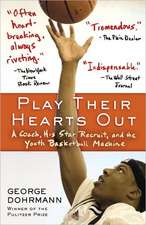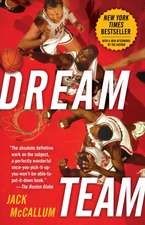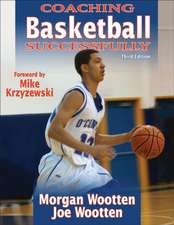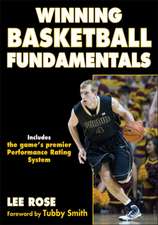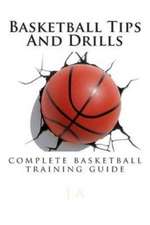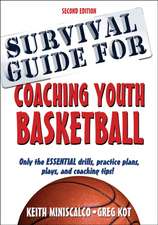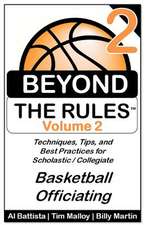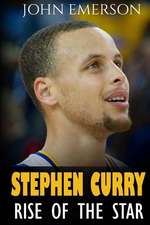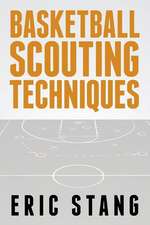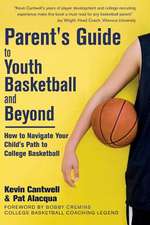The Rivalry: Bill Russell, Wilt Chamberlain, and the Golden Age of Basketball
Autor John Tayloren Limba Engleză Paperback – 31 aug 2006
In the mid-1950s, the NBA was a mere barnstorming circuit, with outposts in such cities as Rochester, New York, and Fort Wayne, Indiana. Most of the best players were white; the set shot and layup were the sport’s chief offensive weapons. But by the 1970s, the league ruled America’s biggest media markets; contests attracted capacity crowds and national prime-time television audiences. The game was played “above the rim”–and the most marketable of its high-flying stars were black. The credit for this remarkable transformation largely goes to two giants: Bill Russell and Wilt Chamberlain.
In The Rivalry, award-winning journalist John Taylor projects the stories of Russell, Chamberlain, and other stars from the NBA’s golden age onto a backdrop of racial tensions and cultural change. Taylor’s electrifying account of two complex men–as well as of a game and a country at a crossroads–is an epic narrative of sports in America during the 1960s.
It’s hard to imagine two characters better suited to leading roles in the NBA saga: Chamberlain was cast as the athletically gifted yet mercurial titan, while Russell played the role of the stalwart centerpiece of the Boston Celtics dynasty. Taylor delves beneath these stereotypes, detailing how the two opposed and complemented each other and how they revolutionized the way the game was played and perceived by fans.
Competing with and against such heroes as Jerry West, Tom Heinsohn, Bob Cousy, John Havlicek, and Elgin Baylor, and playing for the two greatest coaches of the era, Alex Hannum and the fiery Red Auerbach, Chamberlain and Russell propelled the NBA into the spotlight. But their off-court visibility and success–to say nothing of their candor–also inflamed passions along America’s racial and generational fault lines. In many ways, Russell and Chamberlain helped make the NBA and, to some extent, America what they are today.
Filled with dramatic conflicts and some of the great moments in sports history, and building to a thrilling climax–the 1969 final series, the last showdown between Russell and Chamberlain–The Rivalry has at its core a philosophical question: Can determination and a team ethos, embodied by the ultimate team player, Bill Russell, trump sheer talent, embodied by Wilt Chamberlain?
Gripping, insightful, and utterly compelling, the story of Bill Russell and Wilt Chamberlain is the stuff of sporting legend. Written with a reporter’s unerring command of events and a storyteller’s flair, The Rivalry will take its place as one of the classic works of sports history.
From the Hardcover edition.
Preț: 120.89 lei
Nou
Puncte Express: 181
Preț estimativ în valută:
23.14€ • 24.06$ • 19.10£
23.14€ • 24.06$ • 19.10£
Carte disponibilă
Livrare economică 24 martie-07 aprilie
Preluare comenzi: 021 569.72.76
Specificații
ISBN-13: 9780812970302
ISBN-10: 0812970306
Pagini: 421
Dimensiuni: 134 x 202 x 23 mm
Greutate: 0.32 kg
Ediția:Reprint
Editura: BALLANTINE BOOKS
ISBN-10: 0812970306
Pagini: 421
Dimensiuni: 134 x 202 x 23 mm
Greutate: 0.32 kg
Ediția:Reprint
Editura: BALLANTINE BOOKS
Notă biografică
John Taylor, a journalist for more than two decades, has been a contributing editor at New York magazine and a senior writer for Esquire. He is the author of four books, including, most recently, The Count and the Confession, a New York Times Notable Book of the Year, and Falling, which Entertainment Weekly ranked as one of the five best nonfiction books of 1999. He lives in East Moriches, New York, with his wife, Jeannette Walls.
From the Hardcover edition.
From the Hardcover edition.
Extras
Chapter 1
1
ON THE NIGHT of November 7, 1959, people lined up on the sidewalks outside Boston’s North Station, a dingy yellow-brick building, and crowded along the bar at the Iron Horse, the old drinking-parlor inside. They stood in clusters on Causeway Street and Haverhill Street and Canal Street, their voices almost drowned out by the thundering traffic on the elevated highways and subway tracks that crossed above them on iron girders, and by the hiss and clang of the trains in the rail yards.
The citizens of Boston had much to debate that evening. In Washington, D.C., Charles Van Doren, the thirty-three-year-old Columbia University English professor, had just admitted to a congressional committee that the producers of Twenty-One, the television quiz show that had turned him into a national icon, had been secretly prepping him with the answers to questions. Senator John Kennedy, who had all but announced his intention to run for president the following year, had been touring California and Oregon the previous week, greeted by ecstatic crowds carrying signs saying “Viva Kennedy!” In Boston itself, a newspaper strike was under way, and just four days earlier, John Collins, the Suffolk County register of probate and a victim of paralytic polio who was confined to a wheelchair, had defeated Senate president John Powers for the Boston mayoralty. It was a stunning upset, brought about by an FBI raid on the headquarters of a gambling syndicate just one hundred yards from the East Boston police station and resulting in charges of widespread corruption in the city’s government.
But the topic that consumed the crowds around North Station was neither the television scandal nor the impending administration of John Collins nor the presidential prospects of a young Irish American Catholic. It was instead basketball, specifically the game scheduled that night between the Boston Celtics and the Philadelphia Warriors. While Boston was a storied sports town, the sports that had always provoked the most passion were baseball and hockey, the sports of the Red Sox and the Bruins. These were sports with rich local histories, sports that had been played for generations in Boston and had, over the years, woven themselves so deeply into the fabric of the city that residence there seemed virtually synonymous with a rabid devotion to its baseball and hockey teams. Professional basketball, in contrast, was only thirteen years old in 1959. Walter Brown, the owner of the Bruins and leaseholder on the Boston Garden, had started the Celtics to fill seats at the arena on nights when his beloved hockey team was not playing and the big, drafty building, located above the train station, would otherwise sit dark and empty. In other words, the team was a purely commercial afterthought in a sport without strong roots in the city’s culture, and for much of the fifties, attendance at its games reflected this. Rarely was the Garden more than half filled on the nights it played. Members of the Celtics joked that while Ted Williams could not get out of a car on Charles Street without being mobbed, their entire team could walk the length of the Common and no one would give them a second glance.
On the night of November 7, however, every one of the 13,909 seats in the Garden had long been sold out, even the hundreds of seats whose views became partially obstructed when the hockey arena was converted to a basketball court by raising the backboards, running guy wires out to the sides, and bolting the wooden parquet squares to the subflooring. Outside, along Causeway Street, scalpers were demanding upwards of $20 for tickets that usually went for $2.50. One New York sportswriter, arriving at North Station earlier that afternoon, was offered a ticket for $10 by a scalper who told him, “Just trying to do you a favor, Mac. I can get more for it at the Garden just before game time.”
The reason for the excitement was that twenty-three-year-old Wilt Chamberlain had joined the Philadelphia Warriors as a rookie that year and on this night Chamberlain would for the first time face the Celtics center, Bill Russell. The game was so eagerly anticipated that Red Auerbach, the Celtics coach, had been telling people that it would draw enough fans to fill Yankee Stadium. Sportswriters were calling the confrontation Battle of the Titans, Battle of the Giants, and Big Goliath vs. Little Goliath. They were speculating about what would happen when an “irresistible offensive force” encountered an “immovable defensive object.” In an article anticipating the game, Sport magazine’s headline was “The Big Collision,” and it declared, “Pro basketball will be stepping into its golden age when Wilt Chamberlain, the rookie, clashes with Bill Russell, the leaping veteran.”
Chamberlain had attracted national attention even while a student at Overbrook High School in Philadelphia, where his team won fifty-eight games and lost three in his three years there and where he set a statewide scoring record, averaging just under forty points per game. At the University of Kansas, he had proved to be such an overwhelming presence on the court that Jimmy Breslin, then a young sportswriter, wrote an article for The Saturday Evening Post entitled, “Can Basketball Survive Wilt Chamberlain?”
Basketball had had big men before. In the early fifties, George Mikan, the six-foot-ten-inch center of the Minneapolis Lakers, had dominated the game. But Mikan was a lurching, graceless man who wore metal-rimmed glasses and lumbered up and down the court, bashing aside opponents with his huge left arm. Chamberlain was more than seven feet tall and wore size fourteen-and-a-half shoes, but he was also quick, agile, strong, and smart. His legs were so long that he seemed part gazelle. And they were so powerful that when he leaped up, arms raised, toward the backboard, his hands at the apex of his jump were three feet above the rim, which he could look down into. He was so good that not only did no one seem to be able to beat him, few people seemed actually capable of playing against him.
Except maybe Bill Russell. Russell had led the Celtics to two championships since joining the team three years earlier. Never much of a shooter, Russell had nonetheless perfected a style of defensive play, blocking shots and rebounding ferociously by leaping so high into the air that he seemed to hang there in suspension. His size and athleticism had literally transformed professional basketball. Prior to Russell joining the National Basketball Association, the game had consisted of little more than men running up and down the court making layups. But because Russell blocked layups so effectively, players had been forced to create a wider range of offensive plays, passing back and forth and setting screens until one of them could make a mid-range jump shot. The game immediately became more complex, varied, and challenging for the players and more involving and fun to watch for the spectators, and the late fifties became known as the Russell Era.
But now, with Chamberlain in the league, sportswriters were wondering if the Russell Era was coming to an end, if the defensive style of play Russell personified would yield to the singularly muscular offensive style of Wilt Chamberlain, whose fadeaway jump shot was almost impossible to defend against and who amazed fans by leaping up to the rim, taking a pass over the outstretched hands of the defending team, and then, still rising into his jump, actually shoving the ball down into the basket. It was a feat so startling, requiring such a rare combination of timing, grace, and strength, that it seemed to have more to do with acrobatics than with basketball. Until then, the sport had been thought of as a game played well below the net. Now it was becoming a game played in the air.
Russell, sitting in the Celtics locker room before the game, had read the articles musing about an end of an era—his era, even though he was only twenty-six—and he wondered if they were true. Russell had eaten a steak that afternoon and then played cards with his teammates Maurice King and K. C. Jones, who had also been his teammate on the University of San Francisco Dons when he led it to two NCAA championships. Russell always got nervous before a game, so nervous that he routinely threw up. Night after night, sixty or seventy times a season, he was in the head before the game tossing the remains of his lunch. In fact, he did it with such regularity that to his teammates it became a ritualistic sign of good luck. If Russell wasn’t in there puking, they got worried.
But on this night Russell was more nervous than usual, even after the obligatory trip to the head. Russell was tall, six-ten, but Chamberlain had three or four inches on him; Russell didn’t know exactly how many inches, because while Chamberlain was officially listed at seven feet one and one-sixteenth inches, he also claimed that no one had measured him since he was in high school. Also, Russell knew, Chamberlain was a good forty to fifty pounds heavier than he was. He could jump just as high and he was just as quick up and down the court.
And Chamberlain was smart. Russell considered himself one of the most serious students and analysts of basketball ever to play the game. While at San Francisco, he had thought so systematically about the game’s physics and geometry—the trajectories the ball drew between the horizontal plane of the court and the vertical planes of the backboards, the thrust of a 240-pound body hurtling at you at twenty miles an hour and the dynamics of deflecting that thrust—that he thought of himself as a scientist in sneakers. But Russell knew Chamberlain was just as smart as he was. The sportswriters were saying Chamberlain was even smarter. Russell wondered if tonight he was going to be outplayed and outthought by rookie Wilton Norman Chamberlain.
People had been feeding Russell information about Chamberlain for weeks: his moves and shots—particularly his fadeaway jumper—what worked against him, what didn’t, how close to guard him. Prepared as he was, Russell still felt unprepared because Chamberlain, from what so many people were saying, sounded simply unstoppable, a man who was going to get his thirty points regardless of what you did. Russell decided one thing: he would not look up at Chamberlain. Russell was used to being the tallest person in the room or on the court, and there was nothing that a tall person, accustomed to looking down at everyone, found more intimidating than to come face-to-face with someone who was even taller.
Chamberlain had spent the afternoon before the game sprawled diagonally across two beds he’d pushed together in the Hotel Lenox, trying to rest. Basketball fans had learned where he was staying, and a small crowd of them badgered him for autographs when he emerged from the hotel in the early evening. After obliging, he caught a taxi to Boston Garden. Now, sitting in the cramped and overheated visitors’ locker room with the rest of the Warriors, he was nervous as well. His transition into the pros had been more difficult than he’d thought it would be, given his commanding abilities and all the press he’d received. Pro ball was more violent than college ball, for one thing. He’d been elbowed in the mouth by Willie Naulls in a game against the Knicks. And Naulls had chased him up and down the court trying to tear off the rubber band he always wore on his wrist. It was like the guy was out to get him, like there was something personal going on. Also, Chamberlain had played exhibition ball with the Harlem Globetrotters for a year before turning pro, and since the actual games the Trotters played were little more than jokey pretexts for various basketball stunts, he’d picked up a few bad habits such as clowning around and walking with the ball.
But he was adjusting. A bigger problem for Chamberlain going into the game that night against the Celtics was that although he was surrounded by some good players such as Paul Arizin and Guy Rogers, the Warriors lacked Boston’s overall talent. That meant that while Bill Russell could stick to rebounding and rely on Bob Cousy and Bill Sharman to score, Chamberlain would have to play both defense and offense. He’d managed to do this so far against other teams, and the Warriors had won their first three games of the season. But he wondered if he’d live up to all the advance billing, if he could hold his own against the greatest defensive player in the league.
The Celtics fans, overwhelmingly white and working-class, had tended to have conflicting feelings toward Bill Russell, their enthusiasm for him as an athlete undercut by their resentment at the fact that not only was the team dominated by a black man, but he was aloof in manner and from time to time gave voice to his indignation over his country’s—and Boston’s—racial inequities. As a result, the crowd tended to reserve its affection for Bob Cousy, the talented local boy who’d come from Holy Cross and was one of the best ball handlers in the league. But on this night, as the announcer introduced Russell to the almost 14,000 fans in the Garden, the applause, in anticipation of the matchup with Chamberlain, was thunderous. The Tall Man, as some sportswriters had taken to calling him, was finally getting a little appreciation in his adopted hometown.
In mid-court before the tip-off, Russell and Chamberlain shook hands. Russell, unable to help himself, broke his vow not to look at Chamberlain and glanced up. The man was tall. Ever since joining the league two and a half years ago, Russell had been able to do pretty much what he had wanted to do on the court. Now he was facing a man who not only towered over him but could jump and dunk, had huge hands and the strength of a wrestler, and knew how to rebound and could also hit from the outside. In fact, Chamberlain went up so high when he took that outside jumper of his that it was more or less impossible to prevent the shot. How, Russell wondered, was he supposed to play him?
The referee tossed the ball into the air and they both leaped. Russell, finding that he was quicker on his feet, went into the air first and got the tip-off. After that, the game quickly turned into a matchup between Russell and Chamberlain, almost as if it were a form of single combat. For the sportswriters sitting courtside, it was an amazing sight to behold. Those who had watched Russell and Chamberlain play individually before had never seen either man seriously challenged for control of the ball. But tonight was different. It was as if only now had each of them found an opponent worthy of his own talent, for each appeared to be forcing the other to work harder, to stretch further, to demand more of himself.
From the Hardcover edition.
1
ON THE NIGHT of November 7, 1959, people lined up on the sidewalks outside Boston’s North Station, a dingy yellow-brick building, and crowded along the bar at the Iron Horse, the old drinking-parlor inside. They stood in clusters on Causeway Street and Haverhill Street and Canal Street, their voices almost drowned out by the thundering traffic on the elevated highways and subway tracks that crossed above them on iron girders, and by the hiss and clang of the trains in the rail yards.
The citizens of Boston had much to debate that evening. In Washington, D.C., Charles Van Doren, the thirty-three-year-old Columbia University English professor, had just admitted to a congressional committee that the producers of Twenty-One, the television quiz show that had turned him into a national icon, had been secretly prepping him with the answers to questions. Senator John Kennedy, who had all but announced his intention to run for president the following year, had been touring California and Oregon the previous week, greeted by ecstatic crowds carrying signs saying “Viva Kennedy!” In Boston itself, a newspaper strike was under way, and just four days earlier, John Collins, the Suffolk County register of probate and a victim of paralytic polio who was confined to a wheelchair, had defeated Senate president John Powers for the Boston mayoralty. It was a stunning upset, brought about by an FBI raid on the headquarters of a gambling syndicate just one hundred yards from the East Boston police station and resulting in charges of widespread corruption in the city’s government.
But the topic that consumed the crowds around North Station was neither the television scandal nor the impending administration of John Collins nor the presidential prospects of a young Irish American Catholic. It was instead basketball, specifically the game scheduled that night between the Boston Celtics and the Philadelphia Warriors. While Boston was a storied sports town, the sports that had always provoked the most passion were baseball and hockey, the sports of the Red Sox and the Bruins. These were sports with rich local histories, sports that had been played for generations in Boston and had, over the years, woven themselves so deeply into the fabric of the city that residence there seemed virtually synonymous with a rabid devotion to its baseball and hockey teams. Professional basketball, in contrast, was only thirteen years old in 1959. Walter Brown, the owner of the Bruins and leaseholder on the Boston Garden, had started the Celtics to fill seats at the arena on nights when his beloved hockey team was not playing and the big, drafty building, located above the train station, would otherwise sit dark and empty. In other words, the team was a purely commercial afterthought in a sport without strong roots in the city’s culture, and for much of the fifties, attendance at its games reflected this. Rarely was the Garden more than half filled on the nights it played. Members of the Celtics joked that while Ted Williams could not get out of a car on Charles Street without being mobbed, their entire team could walk the length of the Common and no one would give them a second glance.
On the night of November 7, however, every one of the 13,909 seats in the Garden had long been sold out, even the hundreds of seats whose views became partially obstructed when the hockey arena was converted to a basketball court by raising the backboards, running guy wires out to the sides, and bolting the wooden parquet squares to the subflooring. Outside, along Causeway Street, scalpers were demanding upwards of $20 for tickets that usually went for $2.50. One New York sportswriter, arriving at North Station earlier that afternoon, was offered a ticket for $10 by a scalper who told him, “Just trying to do you a favor, Mac. I can get more for it at the Garden just before game time.”
The reason for the excitement was that twenty-three-year-old Wilt Chamberlain had joined the Philadelphia Warriors as a rookie that year and on this night Chamberlain would for the first time face the Celtics center, Bill Russell. The game was so eagerly anticipated that Red Auerbach, the Celtics coach, had been telling people that it would draw enough fans to fill Yankee Stadium. Sportswriters were calling the confrontation Battle of the Titans, Battle of the Giants, and Big Goliath vs. Little Goliath. They were speculating about what would happen when an “irresistible offensive force” encountered an “immovable defensive object.” In an article anticipating the game, Sport magazine’s headline was “The Big Collision,” and it declared, “Pro basketball will be stepping into its golden age when Wilt Chamberlain, the rookie, clashes with Bill Russell, the leaping veteran.”
Chamberlain had attracted national attention even while a student at Overbrook High School in Philadelphia, where his team won fifty-eight games and lost three in his three years there and where he set a statewide scoring record, averaging just under forty points per game. At the University of Kansas, he had proved to be such an overwhelming presence on the court that Jimmy Breslin, then a young sportswriter, wrote an article for The Saturday Evening Post entitled, “Can Basketball Survive Wilt Chamberlain?”
Basketball had had big men before. In the early fifties, George Mikan, the six-foot-ten-inch center of the Minneapolis Lakers, had dominated the game. But Mikan was a lurching, graceless man who wore metal-rimmed glasses and lumbered up and down the court, bashing aside opponents with his huge left arm. Chamberlain was more than seven feet tall and wore size fourteen-and-a-half shoes, but he was also quick, agile, strong, and smart. His legs were so long that he seemed part gazelle. And they were so powerful that when he leaped up, arms raised, toward the backboard, his hands at the apex of his jump were three feet above the rim, which he could look down into. He was so good that not only did no one seem to be able to beat him, few people seemed actually capable of playing against him.
Except maybe Bill Russell. Russell had led the Celtics to two championships since joining the team three years earlier. Never much of a shooter, Russell had nonetheless perfected a style of defensive play, blocking shots and rebounding ferociously by leaping so high into the air that he seemed to hang there in suspension. His size and athleticism had literally transformed professional basketball. Prior to Russell joining the National Basketball Association, the game had consisted of little more than men running up and down the court making layups. But because Russell blocked layups so effectively, players had been forced to create a wider range of offensive plays, passing back and forth and setting screens until one of them could make a mid-range jump shot. The game immediately became more complex, varied, and challenging for the players and more involving and fun to watch for the spectators, and the late fifties became known as the Russell Era.
But now, with Chamberlain in the league, sportswriters were wondering if the Russell Era was coming to an end, if the defensive style of play Russell personified would yield to the singularly muscular offensive style of Wilt Chamberlain, whose fadeaway jump shot was almost impossible to defend against and who amazed fans by leaping up to the rim, taking a pass over the outstretched hands of the defending team, and then, still rising into his jump, actually shoving the ball down into the basket. It was a feat so startling, requiring such a rare combination of timing, grace, and strength, that it seemed to have more to do with acrobatics than with basketball. Until then, the sport had been thought of as a game played well below the net. Now it was becoming a game played in the air.
Russell, sitting in the Celtics locker room before the game, had read the articles musing about an end of an era—his era, even though he was only twenty-six—and he wondered if they were true. Russell had eaten a steak that afternoon and then played cards with his teammates Maurice King and K. C. Jones, who had also been his teammate on the University of San Francisco Dons when he led it to two NCAA championships. Russell always got nervous before a game, so nervous that he routinely threw up. Night after night, sixty or seventy times a season, he was in the head before the game tossing the remains of his lunch. In fact, he did it with such regularity that to his teammates it became a ritualistic sign of good luck. If Russell wasn’t in there puking, they got worried.
But on this night Russell was more nervous than usual, even after the obligatory trip to the head. Russell was tall, six-ten, but Chamberlain had three or four inches on him; Russell didn’t know exactly how many inches, because while Chamberlain was officially listed at seven feet one and one-sixteenth inches, he also claimed that no one had measured him since he was in high school. Also, Russell knew, Chamberlain was a good forty to fifty pounds heavier than he was. He could jump just as high and he was just as quick up and down the court.
And Chamberlain was smart. Russell considered himself one of the most serious students and analysts of basketball ever to play the game. While at San Francisco, he had thought so systematically about the game’s physics and geometry—the trajectories the ball drew between the horizontal plane of the court and the vertical planes of the backboards, the thrust of a 240-pound body hurtling at you at twenty miles an hour and the dynamics of deflecting that thrust—that he thought of himself as a scientist in sneakers. But Russell knew Chamberlain was just as smart as he was. The sportswriters were saying Chamberlain was even smarter. Russell wondered if tonight he was going to be outplayed and outthought by rookie Wilton Norman Chamberlain.
People had been feeding Russell information about Chamberlain for weeks: his moves and shots—particularly his fadeaway jumper—what worked against him, what didn’t, how close to guard him. Prepared as he was, Russell still felt unprepared because Chamberlain, from what so many people were saying, sounded simply unstoppable, a man who was going to get his thirty points regardless of what you did. Russell decided one thing: he would not look up at Chamberlain. Russell was used to being the tallest person in the room or on the court, and there was nothing that a tall person, accustomed to looking down at everyone, found more intimidating than to come face-to-face with someone who was even taller.
Chamberlain had spent the afternoon before the game sprawled diagonally across two beds he’d pushed together in the Hotel Lenox, trying to rest. Basketball fans had learned where he was staying, and a small crowd of them badgered him for autographs when he emerged from the hotel in the early evening. After obliging, he caught a taxi to Boston Garden. Now, sitting in the cramped and overheated visitors’ locker room with the rest of the Warriors, he was nervous as well. His transition into the pros had been more difficult than he’d thought it would be, given his commanding abilities and all the press he’d received. Pro ball was more violent than college ball, for one thing. He’d been elbowed in the mouth by Willie Naulls in a game against the Knicks. And Naulls had chased him up and down the court trying to tear off the rubber band he always wore on his wrist. It was like the guy was out to get him, like there was something personal going on. Also, Chamberlain had played exhibition ball with the Harlem Globetrotters for a year before turning pro, and since the actual games the Trotters played were little more than jokey pretexts for various basketball stunts, he’d picked up a few bad habits such as clowning around and walking with the ball.
But he was adjusting. A bigger problem for Chamberlain going into the game that night against the Celtics was that although he was surrounded by some good players such as Paul Arizin and Guy Rogers, the Warriors lacked Boston’s overall talent. That meant that while Bill Russell could stick to rebounding and rely on Bob Cousy and Bill Sharman to score, Chamberlain would have to play both defense and offense. He’d managed to do this so far against other teams, and the Warriors had won their first three games of the season. But he wondered if he’d live up to all the advance billing, if he could hold his own against the greatest defensive player in the league.
The Celtics fans, overwhelmingly white and working-class, had tended to have conflicting feelings toward Bill Russell, their enthusiasm for him as an athlete undercut by their resentment at the fact that not only was the team dominated by a black man, but he was aloof in manner and from time to time gave voice to his indignation over his country’s—and Boston’s—racial inequities. As a result, the crowd tended to reserve its affection for Bob Cousy, the talented local boy who’d come from Holy Cross and was one of the best ball handlers in the league. But on this night, as the announcer introduced Russell to the almost 14,000 fans in the Garden, the applause, in anticipation of the matchup with Chamberlain, was thunderous. The Tall Man, as some sportswriters had taken to calling him, was finally getting a little appreciation in his adopted hometown.
In mid-court before the tip-off, Russell and Chamberlain shook hands. Russell, unable to help himself, broke his vow not to look at Chamberlain and glanced up. The man was tall. Ever since joining the league two and a half years ago, Russell had been able to do pretty much what he had wanted to do on the court. Now he was facing a man who not only towered over him but could jump and dunk, had huge hands and the strength of a wrestler, and knew how to rebound and could also hit from the outside. In fact, Chamberlain went up so high when he took that outside jumper of his that it was more or less impossible to prevent the shot. How, Russell wondered, was he supposed to play him?
The referee tossed the ball into the air and they both leaped. Russell, finding that he was quicker on his feet, went into the air first and got the tip-off. After that, the game quickly turned into a matchup between Russell and Chamberlain, almost as if it were a form of single combat. For the sportswriters sitting courtside, it was an amazing sight to behold. Those who had watched Russell and Chamberlain play individually before had never seen either man seriously challenged for control of the ball. But tonight was different. It was as if only now had each of them found an opponent worthy of his own talent, for each appeared to be forcing the other to work harder, to stretch further, to demand more of himself.
From the Hardcover edition.


